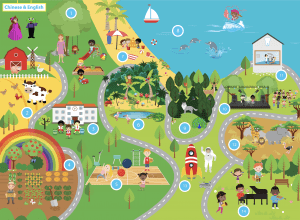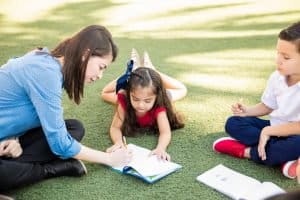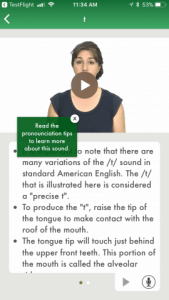
K atie Novak explains why the implementation of universal design for learning (UDL) is best practice to increase engagement in all students
atie Novak explains why the implementation of universal design for learning (UDL) is best practice to increase engagement in all students
In 1922, my grandmother moved from Trois-Rivières, a city in Quebec, Canada, at the age of eleven. Speaking only French, and traveling with her older sister, she was determined to learn English once she arrived. Each day, after she finished her official au pair duties, she walked to the local market to teach herself English. Her textbooks? The handwritten signs posted above the food and day-old newspapers. Her teachers? The store owner and passersby completing their nightly shopping.
Before she died, she bragged that she was fluent in groceries long before she mastered conversational English. Her strategy was simple, she said. She befriended the store owner, who gave her the permission she needed to amble around the store, picking up fruits, vegetables, boxes of cereal, and newspapers. And if the signs did not exist?
She would pick up a shiny apple or a handful of walnuts and ask anyone who would listen, “Qu’est-ce que c’est?” She recalls the kindness of her strangers, always patient as they helped build her comprehension and provided her with feedback.
Without any formal education beyond third grade, Mémère became fluent in English because of her daily market visits. Knowing now what I know about education, it is clear that Mémère’s “teachers” exemplified the principles of universal design for learning (UDL), a framework that provides options to ensure that all students have the opportunity to experience growth and success. Mémère got not just one way but a whole basket of tips and assistance to learn English.
The Building Blocks of UDL
The Every Student Succeeds Act (ESSA) urges states to adopt UDL in a number of areas. For example, it says assessments should be designed using the principles of UDL. It also requires schools to use the principles of UDL to support the learning needs of all students, including English learners (ESSA, 2015, Section 4104).
In a recent publication of WIDA Focus On, a series of bulletins on topics of interest to educators of English language learners, it notes, “Accessibility principles, including processes like Universal Design for Learning (CAST, 2008), can help educators rethink how they position language development support within activities.” The building blocks of UDL include three core principles, which remind educators to provide options to ensure that all students have equal opportunities to access and engage with rigorous academic curriculum.
Provide Multiple Means of Representation
The first principle of UDL reminds educators to provide multiple means of representation to build knowledge and comprehension in all learners. In the case of my Mémère, she had manipulatives: pungent onions, stalks of celery, and newspapers that stamped her fingers with black ink. But that was not enough for her to develop and use English. In addition, she had options to build background knowledge by accessing visual support through pictures and words and accessing auditory support through conversations with individuals who encouraged her language expression.
She also had access to her native language, as the storeowner spoke French. We can foster multiple means of representation in the classroom by providing all students with access to visual support as well as the option to listen to texts in English via peer reading, audio books, and text-to-speech.
One of my colleagues, ELL teacher Cheney Harper, designed a lesson for her students on the rainforest and took them on a “virtual field trip.” At the beginning of the lesson, Cheney welcomed all students at the door, which was decorated with a lush, green poster of the rain forest. She then opened up an “explorer backpack,” from which she gave them each rain forest props to begin their rain forest scavenger hunt.
Each student received a scavenger hunt list, and they had to find twelve animals that live in the rain forest by searching around the classroom and in books. In the classroom, she had hidden twelve stuffed animals, each attached to informational text that provided details about the animals. As they found the animals, she identified the names of the animals (i.e., jaguar, caiman, speckled bear) and shared characteristics of the animals.
She then took them on a “rain forest tour” on the iPad so they could build more background knowledge on the rain forest. As they worked, they had access to translation software and dictionaries, so they had access to their native languages. Having access to the multiple means of representation allowed all students to actively participate in the activity, learn academic vocabulary, and engage with peers in a fun, meaningful way.
Provide Multiple Means of Action and Expression
It is not enough to comprehend information if there is no way to express it. Students need numerous methods to express their understanding as they develop into writers and speakers.
When we examine the Common Core State Standards, teaching methods, materials, and assessments are not outlined. This provides us with an opportunity to create multiple pathways to meet the same destination by providing students with options.
This is no accident, as the Common Core endorses UDL as the framework to support all students as they reach for the standards. The standards are only the “what.” UDL is the “how.”
There are many different paths to reach the same destination. We, as educators, need to embrace the many possible journeys that our students can take in order to arrive at the same place. Traditional assessments are one-size-fits-all and expect the same product from all students (i.e., everyone is expected to write informative text as a five-paragraph essay).
UDL encourages multiple options for expression and multiple scaffolds to help all students reach the goal. Take the anchor standard, “Write informative/explanatory texts to examine and convey complex ideas and information clearly.”
Sentence frames, graphic organizers, collaborative work, exemplars, and the use of the WIDA English Language Development Standards provide necessary supports that allow all students to express what they know in inclusive, diverse classrooms while working toward the same standard. Additionally, since students master speaking before writing, educators may provide English learners the option to audio record their learning, supplement with visuals, or use voice-recognition software to scaffold the language process as they continue to develop into writers.
Provide Multiple Means of Engagement
Engagement is at the core of all learning experiences. If we want students to learn, we have to foster both attention and commitment by providing students with authentic, meaningful experiences in learning. All students need access to options that help them connect their own cultural backgrounds to new learning activities, as well as access to their peers to foster collaboration and community. In order to master a skill, one needs practice.
A lot of practice. Peers provide an amazing opportunity for English learners to practice speaking in the classroom. Just as my Mémère befriended countless customers at the market, our students need to interact with their peers.
From “do-nows” to brainstorming sessions to collaborative discussions, authentic opportunities to build language with others are what build a solid foundation to learn academic English. Teachers can observe these collaborative conversations, informally assess students, and give feedback on their language structures and use of vocabulary to provide additional means for action and expression in authentic settings.
These three principles of UDL—provide multiple means of representation, provide multiple means of action and expression, and provide multiple means of engagement—remind all educators to ensure that English language learners always have the option to build background knowledge, interact with information visually and auditorily, access rich scaffolds and supports to help highlight the patterns of language, and have numerous opportunities to express what they know in ways that are authentic and meaningful, all while experiencing the value of collaboration and feedback.
Of course, in the early 1900s, my grandmother had no concept of universal design for learning, nor did her teachers. David Rose, Anne Meyer, and their colleagues at CAST would not articulate the UDL principles until the very end of the century. But something happened in that marketplace which exemplifies what we want teaching and learning to look like today.
Now that we have a framework that is intertwined with our Common Core State Standards, WIDA briefs, and federal legislation, it is time to optimize and scale the framework in all classrooms. Let us make that happen so our students can experience the same magic that my Mémère did, as she learned to appreciate the power of language.
Katie Novak, EdD, is the assistant superintendent of the Groton-Dunstable Regional School District in Massachusetts and a leading expert on universal design for learning implementation. She is the author of four books, including UDL Now! (CAST Professional Publishing, 2016), Universally Designed Leadership (CAST, 2016), and Let Them Thrive (CAST, 2017). Learn more at http://www.katienovakudl.com.

 The constitutional crisis in Spain’s autonomous region of Cataluña may soon affect its classrooms. Madrid’s control over Catalan regional affairs is continuing in the wake of the region’s inability to form a government following December’s election, a situation that began after the Catalan parliament declared unilateral independence in late October.
The constitutional crisis in Spain’s autonomous region of Cataluña may soon affect its classrooms. Madrid’s control over Catalan regional affairs is continuing in the wake of the region’s inability to form a government following December’s election, a situation that began after the Catalan parliament declared unilateral independence in late October.


 More than half a millennium after most Jews were expelled from the country in 1492, Spain is officially recognizing their language, Ladino, as a type of Spanish.
More than half a millennium after most Jews were expelled from the country in 1492, Spain is officially recognizing their language, Ladino, as a type of Spanish.
 Michael Haggen explains how summer reading is an integral and achievable part of every district’s comprehensive literacy plan
Michael Haggen explains how summer reading is an integral and achievable part of every district’s comprehensive literacy plan
 atie Novak explains why the implementation of universal design for learning (UDL) is best practice to increase engagement in all students
atie Novak explains why the implementation of universal design for learning (UDL) is best practice to increase engagement in all students Little Sponges is the first and only interactive bilingual curriculum that leverages the power of real-life videos and interactive games to teach young students listening, speaking, and reading skills in multiple languages: English, Spanish, Chinese, French, German, and Russian. The web-based platform enables personalized learning on any device for children ages two to eight. The research-based curriculum integrates language learning and academic content across the main learning domains.
Little Sponges is the first and only interactive bilingual curriculum that leverages the power of real-life videos and interactive games to teach young students listening, speaking, and reading skills in multiple languages: English, Spanish, Chinese, French, German, and Russian. The web-based platform enables personalized learning on any device for children ages two to eight. The research-based curriculum integrates language learning and academic content across the main learning domains.
 Listenwise builds listening comprehension across the curriculum. Listenwise is a website that offers teachers free access to curated NPR public radio stories and podcasts. It features an audio library offering thousands of curated NPR stories that are aligned to curriculum topics and state standards. Listenwise provides access to high-quality academic language, channeled through engaging content, which is invaluable for all students, especially English language learners.
Listenwise builds listening comprehension across the curriculum. Listenwise is a website that offers teachers free access to curated NPR public radio stories and podcasts. It features an audio library offering thousands of curated NPR stories that are aligned to curriculum topics and state standards. Listenwise provides access to high-quality academic language, channeled through engaging content, which is invaluable for all students, especially English language learners. Anyone who has taught university-level English language learners knows that no matter how well they may have performed in their English language courses, they are usually not prepared for the shock of the real university classroom, which includes massive amounts of reading, competing in a classroom of native speakers, listening to hour-long lectures, and writing papers without their helpful English teachers nearby. How to help EAP students bridge this gap has been a subject of research and experimentation by English language teaching professionals for the last several decades, myself included. Delineating and then breaking down those necessary skills that native-English-speaking students take for granted has been a struggle for those of us working with this student population.
Anyone who has taught university-level English language learners knows that no matter how well they may have performed in their English language courses, they are usually not prepared for the shock of the real university classroom, which includes massive amounts of reading, competing in a classroom of native speakers, listening to hour-long lectures, and writing papers without their helpful English teachers nearby. How to help EAP students bridge this gap has been a subject of research and experimentation by English language teaching professionals for the last several decades, myself included. Delineating and then breaking down those necessary skills that native-English-speaking students take for granted has been a struggle for those of us working with this student population. Third-grade teacher Enolar Callands used to spend hours tracking down quality stories to support the ELA standards. “It could take forever,” she explains. The selections she found were “mundane” and drained students’ enthusiasm for reading. Her fellow teachers at Beecher Hills Elementary in Atlanta faced similar issues. After searching for a schoolwide solution for 2016–2017, the school chose Total Motivation ELA from Mentoring Minds because of its close standards alignment, rigor, and critical thinking emphasis.
Third-grade teacher Enolar Callands used to spend hours tracking down quality stories to support the ELA standards. “It could take forever,” she explains. The selections she found were “mundane” and drained students’ enthusiasm for reading. Her fellow teachers at Beecher Hills Elementary in Atlanta faced similar issues. After searching for a schoolwide solution for 2016–2017, the school chose Total Motivation ELA from Mentoring Minds because of its close standards alignment, rigor, and critical thinking emphasis. When faced with the challenge of improving their pronunciation skills, most people feel that there is no replacement for the connection that occurs with face-to-face communication. Yet how can we help those who, for whatever reason, are unable to access quality one-on-one instruction? That was the dilemma that Keri Jones, a speech language pathologist with over 18 years of experience, set out to address. With guidance from the Center for Learning and Innovation at Pullman Regional Hospital, Jones and her team created an app called Speech Sounds Visualized.
When faced with the challenge of improving their pronunciation skills, most people feel that there is no replacement for the connection that occurs with face-to-face communication. Yet how can we help those who, for whatever reason, are unable to access quality one-on-one instruction? That was the dilemma that Keri Jones, a speech language pathologist with over 18 years of experience, set out to address. With guidance from the Center for Learning and Innovation at Pullman Regional Hospital, Jones and her team created an app called Speech Sounds Visualized.